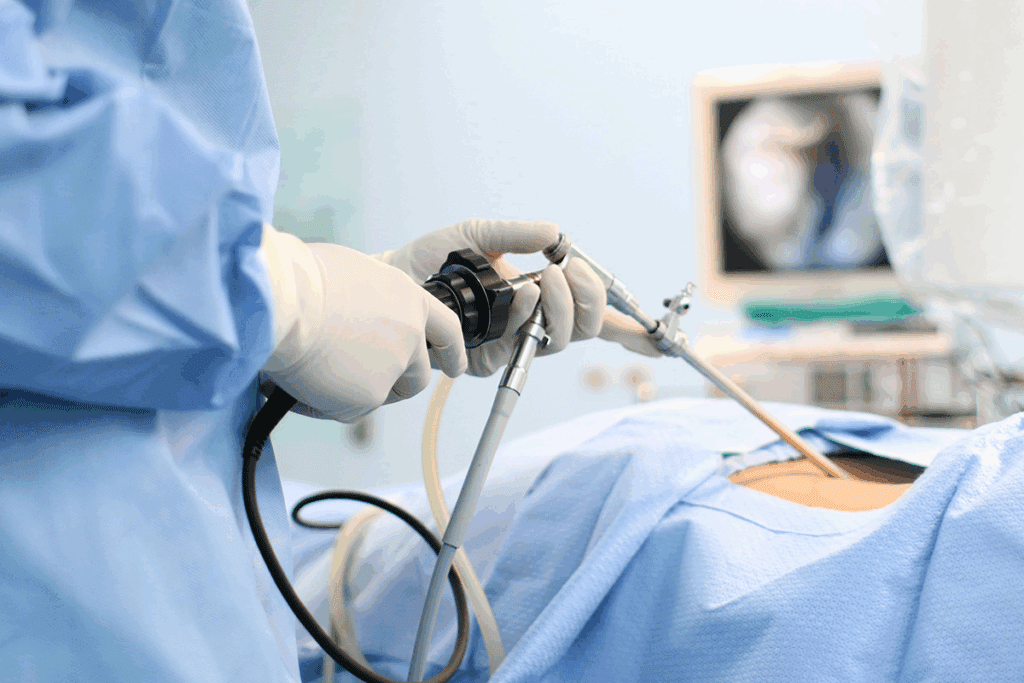Last Updated on November 26, 2025 by Bilal Hasdemir

The gallbladder is a small, pear-shaped organ. It’s key to digestion. It stores and concentrates bile from the liver. This bile is released into the small intestine when we eat fatty foods.
This action helps break down and absorb fats. Many people ask, what does the gallbladder do, and understanding this shows how important the gallbladder is for our health. Knowing its role helps us see why keeping it healthy is vital.

Knowing how the gallbladder works is important. It’s a small, pear-shaped organ under the liver. It helps a lot with digestion.
The gallbladder is about 3 to 4 inches long and 1 inch wide. It has three parts: the fundus, body, and neck. The fundus is the rounded end, the body is the main part, and the neck connects to the cystic duct.
The gallbladder sits in a depression on the liver, called the gallbladder fossa. This spot is key because the liver makes bile. The bile goes to the gallbladder through the cystic duct.
This duct also joins with the common hepatic duct. Together, they form the common bile duct.
The gallbladder is part of the biliary system. This system includes the liver, gallbladder, and bile ducts. Its main job is to store and make bile more concentrated.
When fatty foods reach the small intestine, the gallbladder releases bile. This bile goes into the small intestine. There, it helps digest fats.
To sum up, the gallbladder’s shape and where it is help it do its job. It stores bile and connects to the liver and small intestine. This lets it play a big part in breaking down fats.

The gallbladder’s main job is to store and concentrate bile. Bile is a digestive fluid made by the liver. It’s key for breaking down fats.
The gallbladder holds bile from the liver. Bile has bile salts, cholesterol, and bilirubin. It makes bile more effective for fat digestion by removing extra water and salts.
Key aspects of bile concentration include:
When we eat fatty foods, the gallbladder contracts. It releases concentrated bile into the small intestine. This is triggered by hormones, mainly cholecystokinin (CCK), from the duodenum.
The bile release mechanism involves:
This complex process shows how vital the gallbladder is for fat digestion. It’s clear why the gallbladder plays a big role in our digestive system.
Bile is key to breaking down fats and getting nutrients into our bodies. It’s a complex fluid that’s vital for digestion.
Bile is a yellowish-brown liquid made of bile salts, cholesterol, and bilirubin. These elements help digest and absorb fats. The properties of bile make it possible to break down fats into smaller pieces for enzymes to digest.
The liver makes bile, producing about 27 to 34 fluid ounces every day. Hepatocytes, the liver’s main cells, create bile from cholesterol, bile acids, and bilirubin.
Bile production never stops. The liver keeps making bile, which then goes to the gallbladder for storage and concentration.
Bile moves from the liver through the hepatic ducts into the common bile duct. It can either go to the gallbladder or straight to the small intestine.
When food reaches the small intestine, the gallbladder releases bile. This concentrated bile helps with fat digestion.
The gallbladder is key in fat digestion. It releases bile into the small intestine. This bile helps break down and absorb fats.
Bile salts turn large fat globules into smaller ones. This emulsification process is vital for fat digestion. It makes fats easier for enzymes to break down and absorb.
Bile’s emulsification of fats is also key for vitamin absorption. Vitamins A, D, E, and K are vital for health. They help with vision, bone health, antioxidants, and blood clotting. Good fat emulsification is needed for their absorption.
The gallbladder’s role in bile concentration is important. Concentrated bile has more bile salts. These salts are better at breaking down fats. This makes digestion more efficient and nutrient absorption better.
| Function | Description | Benefit |
| Bile Emulsification | Breaks down large fat globules into smaller droplets | Increases surface area for enzymatic action |
| Absorption of Fat-Soluble Vitamins | Facilitates the absorption of vitamins A, D, E, and K | Essential for various bodily functions |
| Concentrated Bile | Enhances the efficiency of fat digestion | Improves nutrient absorption |
In summary, the gallbladder is vital for fat digestion and nutrition. It releases bile that emulsifies fats, aids in vitamin absorption, and boosts digestion efficiency.
The gallbladder helps our digestive system work better. It stores and releases bile, which is key for fat digestion.
The gallbladder makes digestion more efficient. It stores bile from the liver and concentrates it. This concentrated bile helps break down fats in the small intestine.
This is very important after eating fatty foods. It helps our body digest fats better. The gallbladder’s role in releasing bile makes digestion smoother.
The gallbladder adjusts to how much fat we eat. When we eat fatty foods, it releases bile into the small intestine. This helps break down fats for better absorption.
It’s vital for our digestive health, no matter the fat content of our meals. The gallbladder ensures fats are digested and absorbed properly.
The gallbladder is important for all kinds of meals, not just fatty ones. It stores bile for any meal, ready to release it when needed. This shows its constant role in our digestive health.
In summary, the gallbladder is more than just a storage organ. It helps digest food by optimizing efficiency and responding to fat intake. Knowing its role helps us keep our digestive system healthy.
The gallbladder’s role in digestion depends on what you eat. It’s not vital, but it helps a lot with fat digestion. This is true for those who eat a lot of fat.
The gallbladder is like other organs like the liver, pancreas, and stomach. But it’s not as key. The liver makes bile, and the pancreas makes enzymes. The stomach mixes food for digestion.
The gallbladder mainly stores bile. It releases it into the small intestine. This helps with fat digestion.
The gallbladder is very important for high-fat meals. It helps break down fats. This is key for absorbing vitamins A, D, E, and K.
“The gallbladder is a small, pear-shaped organ that plays a significant role in the digestive system by storing and concentrating bile.”
The gallbladder’s role changes with diet. It’s very important for those who eat a lot of fat. But for low-fat diets, it’s less needed.
In summary, the gallbladder’s role in digestion depends on diet and health. It’s not vital, but it’s important for fat digestion, mainly for those on high-fat diets.
Removing the gallbladder, or cholecystectomy, is a common surgery. It can change how we digest food. Knowing these changes helps keep our digestive system healthy.
After surgery, the liver keeps making bile. But it goes straight to the small intestine. This can affect how we digest fats.
Some people might have:
Over time, the body gets used to not having a gallbladder. The bile ducts can stretch and help with bile flow. But how well they adapt varies from person to person.
Key adaptations include:
After surgery, changing what we eat can help. This might include:
These changes can help manage digestive issues after surgery. It’s wise to talk to a healthcare provider or dietitian for specific advice.
The gallbladder plays a key role in our digestion. It can face several conditions that affect its work. Knowing about these issues helps us see how important the gallbladder is for our health.
Gallstones are hard particles that form in the gallbladder. They can cause severe pain in the upper right abdomen, known as biliary colic. This pain often happens after eating fatty foods.
Cholecystitis is when the gallbladder gets inflamed. It’s usually caused by gallstones blocking the cystic duct. This can lead to severe pain, fever, and serious health risks if not treated quickly. It’s important to get medical help right away.
“Cholecystitis is a serious condition that requires immediate medical attention to prevent further complications.”
Even without gallstones, the gallbladder can have problems. This is called biliary dyskinesia. It happens when the gallbladder doesn’t contract right, leading to poor bile release. Symptoms can include abdominal pain and digestive problems.
When gallbladder issues start to affect a person’s life or health, medical help is needed. Treatment can be medication or surgery, depending on the situation. For example, removing the gallbladder is often done for severe cases.
Knowing when to seek medical help is key to managing gallbladder problems. Early treatment can greatly improve health outcomes.
The gallbladder plays a key role in breaking down fats and absorbing nutrients. It stores and concentrates bile from the liver. Even though you can live without it, having a gallbladder makes digestion better, mainly with fatty foods.
Knowing how the gallbladder works in digestion shows its big role in health. People without a gallbladder might need to change their diet to handle digestion better.
Keeping the gallbladder healthy helps avoid problems like gallstones and cholecystitis. By understanding its role, we can take care of our digestive health. This helps us make smart choices for our well-being.
The gallbladder stores and concentrates bile. It releases this bile into the small intestine. This helps with fat digestion and absorption.
The gallbladder makes digestion more efficient, mainly after eating fatty foods. It releases concentrated bile to break down fats.
The gallbladder is key for fat digestion and absorption. It’s a vital part of the digestive system, even if it’s not essential for survival.
Yes, living without a gallbladder is possible. But, you’ll need to make some diet changes to keep digestion running smoothly.
Without a gallbladder, your body must adjust to not having bile storage. This might lead to digestive changes and the need for diet changes.
Common issues include gallstones, biliary colic, cholecystitis, and gallbladder dysfunction without stones. These can affect digestion.
The gallbladder releases more bile when you eat a lot of fat. This helps with fat digestion and absorption.
Yes, the gallbladder is very important for digestion. It’s even more so for people who eat a lot of fat.
Bile breaks down dietary fats, making them easier to digest and absorb. It’s also key for absorbing fat-soluble vitamins.
The liver makes bile, which the gallbladder stores and concentrates. Then, it releases bile into the small intestine.
Subscribe to our e-newsletter to stay informed about the latest innovations in the world of health and exclusive offers!